
Cuyahoga Valley National Park is an American national park that preserves and reclaims the rural landscape along the Cuyahoga River between Akron and Cleveland in Northeast Ohio.
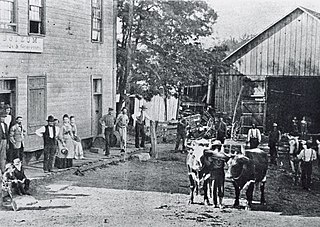
Botzum was a hamlet in Northampton Township, Summit County, Ohio around what is now the intersection of Bath and Riverview Roads in Akron and Cuyahoga Falls.

Samuel Augspurger Farm is a historic building near Trenton, Ohio, listed on the National Register of Historic Places in 1984.

The John Scott Farm is a historic farmstead near the community of Shandon, Ohio, United States. Established in the nineteenth century and still in operation in the twenty-first, the farmstead has been named a historic site because of its traditionally built agricultural structures.
This is a list of the National Register of Historic Places listings in Cuyahoga Valley National Park.

The Overmyer–Waggoner–Roush Farm is a historic farmstead on the southern edge of the village of Lindsey in the northwestern part of the U.S. state of Ohio. Composed primarily of buildings constructed in the middle of the nineteenth century, it has been converted into a park and designated a historic site.

The Michaels Farm is a historic homestead in the northwestern part of the U.S. state of Ohio. Composed of simple vernacular structures and buildings with clear architectural stylistic influences, the farm has been home to members of the same families for nearly two hundred years, and it has been named a historic site.
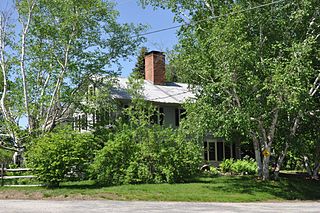
Bennett Farm is a historic farmstead at 11 Bennett Road in Henniker, New Hampshire. The area has been farmed since the 1730s, when Henniker was laid out, and has been in the Bennett family for over a century. It is the oldest surviving farmstead in the rural community, and was listed on the National Register of Historic Places in 2002.

The Dimond Hill Farm is a historic farm at 314 Hopkinton Road in the western rural section of Concord, New Hampshire. Established on land that was first farmed by Ezekiel Dimond in the mid-18th century, this area has been farmed by the members of the Abbott-Presby family since 1827, and is one of the few remaining working farms in the city. The main house is an 1892 rambling structure that connects the family living space with the large barn, which dates to c. 1882. The oldest structure on the farm is a corn crib from the 1850s. The farm was listed on the National Register of Historic Places in 2007. The owners operate a farm stand on a seasonal basis.

The Smith-Duncan House and Eastman Barn are two historic buildings located on the Duncan Farmstead at Pere Marquette State Park in Jersey County, Illinois. The Smith-Duncan House is a two-story limestone house built circa 1861. The house has a double-pile plan, in which each story is two rooms deep, with a central hall. The Eastman Barn has three interior sections and is built on a raised limestone foundation; this arrangement allowed for threshing and storage to be done in the barn and provided a basement space for livestock. A gabled cupola on the barn's roof allows for air to vent from the structure. Both buildings, as well as two contributing retaining walls on the property, are well-preserved examples of local stonework; limestone was a common building material in the Grafton area during the mid-19th century.

The Parsons–Piper–Lord–Roy Farm is a historic farmstead at 309 Cramm Road in Parsonsfield, Maine. Its buildings dating to 1844, it is a fine example of a well-preserved mid-19th century farmstead, with modifications in the 20th century to adapt the barn to chicken farming. The property was listed on the National Register of Historic Places in 2005.

Park Farm is a historic farm property at 26 Woodchuck Hill Road in Grafton, Vermont. With a farmhouse dating to about 1820, and most of its outbuildings to the 19th century, the farm remains an excellent example of a typical 19th-century Vermont farmstead. The property was listed on the National Register of Historic Places in 2003.

The Brugjeld–Peterson Family Farmstead District, also known as Lakeside Farm and the Peterson Point Historical Farmstead, is a historic district in rural Emmet County, Iowa, United States, near the town of Wallingford. It was listed on the National Register of Historic Places in 2000.

The King Farm is a historic farm property at King Farm Road in Woodstock, Vermont. Encompassing more than 150 acres (61 ha) of woodlands and pasture, the farm has 150 years of architectural history, include a rare 18th-century English barn. Originally a subsistence farm, it became a gentleman's farm in the late 19th century, and its farmstead now hosts a regional government commission. The farm was listed on the National Register of Historic Places in 1997.
The Dan Johnson Farmstead is a historic farm property on United States Route 2 in Williston, Vermont. It was first developed in 1787 by Dan Johnson, one of Williston's first settlers, and has remained in his family since that time. The property includes three 19th-century houses and a large barn complex, as well as more than 200 acres (81 ha) of land crossed by US 2 and Interstate 89. It was listed on the National Register of Historic Places in 1993.

Drake Farm is a historic farmstead at 148 Lafayette Road in North Hampton, New Hampshire. Built in 1890, the main farmhouse is a well-preserved example of a connected New England farmstead. It was listed on the National Register of Historic Places in 2016.
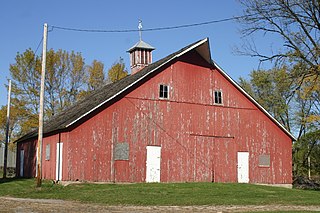
Seminole Valley Farmstead is a collection of historic farm buildings located in Seminole Valley Park on the west side of Cedar Rapids, Iowa, United States. The historic designation includes the farmhouse, summer kitchen, livestock barn, tool shed, ice house, chicken house, and smokehouse. There is also a small orchard and a garden. The complex is located near a bend in the Cedar River. The farm represents a transitional period between Iowa's austere pioneer farms and the mechanized farms that developed later in the 20th century. The nearby timber was a source of raw materials for the farm, the fertile bottomland on which it is located provided rich soil for grazing and cultivation, and the smokehouse and ice house were used to preserve agricultural products for later consumption. At the same time the barn and the chicken house were more substantial than those from earlier times. It was listed on the National Register of Historic Places in 1976.
The Meyers Farmstead Historic District, also known as the Jacob E. and Amanda Meyers Farm and the John B. and Ella Meyers Farm, is an agricultural historic district located in Lisbon, Iowa, United States. It was listed on the National Register of Historic Places in 2021. At the time of its nomination it consisted of six resources, which included two contributing buildings, two contributing structures, and two contributing objects. The historic buildings include a heavy timber frame Pennsylvania banked barn (1870s) and a feeder/hay barn. The historic structures include a combination corn crib/hog house (1880s) and a concrete silo. The contributing objects include a concrete watering trough and water pump and a metal gateway. The farmhouse is also extant but was separated from the rest of the farm buildings when South Jefferson Street was extended in 2002. That separation and the modifications made to it over the years has led to its loss of historical integrity
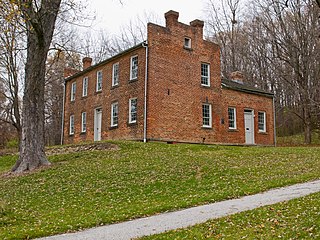
The Stephen Frazee House is a historic house at 7733 Canal Road in Cuyahoga Valley National Park in the U.S. state of Ohio. The house was built in 1826 for Stephen and Mehitable Frazee, who had settled in the Cuyahoga Valley a decade earlier. The family had relocated from Poland, Ohio and were among the valley's first settlers; they lived in a log cabin until building the 1826 house. The construction of the Ohio and Erie Canal in the 1820s split Frazee's land in half, and he won $130 from the state in compensation that he may have put toward the house. The house is a Federal style vernacular building; while the style was common in the northeastern U.S., where it was often implemented by professional architects, it was rare in Ohio. The house's bricks were made of clay from the property itself, and the crude bricks and less experienced builders resulted in the house settling during its construction, giving it a permanent warped appearance. The Frazee family lived in the house until 1861, when it was purchased by John Hynton.
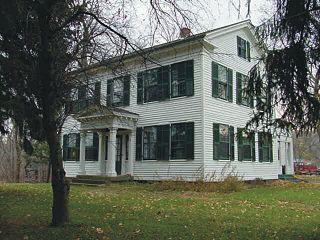
The George Stanford Farm is a historic farm at 6093 Stanford Road in Boston Township, Ohio, within the boundaries of Cuyahoga Valley National Park. The farm, which overlooks the Cuyahoga River and Ohio and Erie Canal, was settled in 1806 by James and Polly Stanford and their children. Their son George built the main farmhouse circa 1830. The Stafford family played an important role in the history of Boston Township; James reportedly suggested its name, and both George and his son George C. held government offices in the township. The farmhouse has a Greek Revival design with a pedimented front porch supported by Greek columns, pilasters flanking the entrance, six-over-six windows, and a gable roof with a box cornice. The property also includes a barn, a springhouse, a garage, a smoke house, a chicken coop, and a corn crib.


















